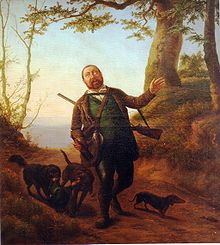Holthausen Slate Mining and Local History Museum
The Westphalian Slate Mining and Local History Museum Holthausen is a museum in the Holthausen district of Schmallenberg in the Hochsauerlandkreis . The Südwestfälische Galerie has been affiliated since 2009 .
history
The museum began its collection in 1974, since then the Schmallenberg mayor Rötger Belke-Grobe has been its chairman. It was opened in 1975 in a former school. Today the museum has over 2,500 m² of exhibition space. It is run by the Museum Association Holthausen e. V. and supported by the city of Schmallenberg. In 2009 the Südwestfälische Galerie was added.
The museum is the editor of numerous publications on regional history. In addition, the museum association has published a number of publications and documentation for the annual museum weeks.
Subject areas
The museum includes the slate , flora and fauna, textile processing, folklore, printing workshop and art departments. In addition to the organization of the permanent exhibition, special exhibitions on other topics are also regularly shown.
Subject areas of the permanent exhibition:
- The slate mining can look back on a long tradition and still exists in the Sauerland . In the slate department, all types of processing of the slate are shown, from mining to completion. The museum's own gallery transports the visitor directly into the underground mining.
- In the natural history section, the local flora and fauna, hunting and timber industry of today are presented.
- Another department is dedicated to textile production in the Sauerland and especially in the Schmallenberg area. The first knitting machine was installed in Schmallenberg in 1869. Textile processing quickly grew into the largest branch of industry around the city.
- The permanent exhibition entitled "Witches' jurisdiction in the Sauerland region of Cologne" has existed since 1984 and is funded by the Westphalia-Lippe Regional Association. The extent of the witch trials in the Sauerland is documented and various torture tools are shown. Westphalian critics of the witch trials were Anton Praetorius , Friedrich Spee and Michael Stappert .
- An old printing and bookbinding shop can be viewed in the "Economic Life" section.
South Westphalian Gallery

The Südwestfälische Galerie was designed as a separate department of the museum in a new building. Regional art - mainly from the 19th and 20th centuries - is shown as a permanent exhibition on around 250 m². The broad spectrum of artistic creation is presented under thematic aspects:
- Sauerland landscapes
- Pictures of people
- Artist travel
- Images from the world of life and work
In addition to Paul Hermann Schoedder , Hinrich Grauenhorst and Carl Siebert , the artists represented in the collection also include Eberhard Viegener , Reinhold Bicher , Josef and Gebhard Schwermer , Jochen Geilen, Hermann Springborn , Heinrich Poertgen, Johannes Dröge, Josef Voss, Hermann Falke and many more . The sculptor Eugen Senge-Platten had a special relationship with the material slate , to which a separate room is dedicated.
The Südwestfälische Galerie is the only museum that deals specifically with the art of the Sauerland and conveys it as an important factor in regional cultural history.
location
- Address: Westfälisches Schieferbergbau- und Heimatmuseum Holthausen, Kirchstrasse 7, 57392 Schmallenberg-Holthausen
Web links
- Official website
- "Südwestfälische Galerie" in the Slate Mining and Local History Museum in Holthausen
- "The Westphalian Slate Mining and Local History Museum Holthausen" (article)
Coordinates: 51 ° 10 ′ 58.9 ″ N , 8 ° 20 ′ 18.2 ″ E
